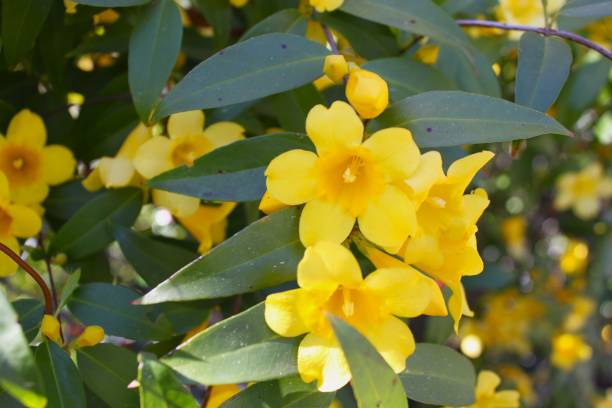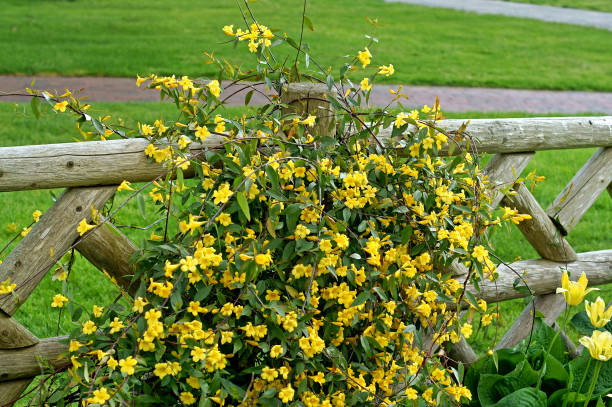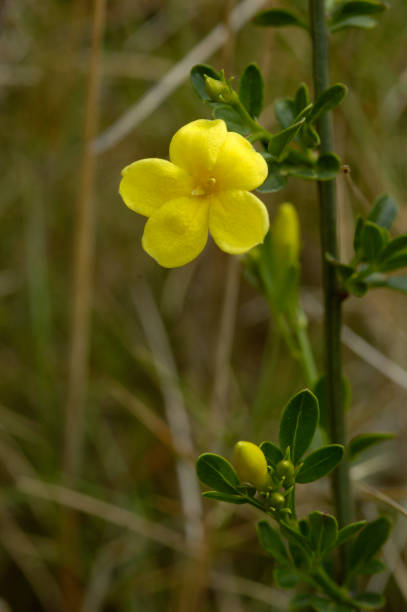Is Yellow Jasmine Poisonous?
Yellow Jasmine or Carolina Jasmine possesses extremely severe poisonous characteristics. Humans have been poisoned, especially children, by sucking nectar from the flowers, mistaken as honeysuckle. There is a risk for dogs that eat any part of the plant. Seizures, breathing difficulties, and death can follow the initial symptoms of muscle weakness and paralysis. All livestock, like cattle, goats, chickens, and geese. Horses are also affected by this plant’s toxicity. The flowers, leaves, and roots are poisonous.
From Virginia to Florida and west to Mexico, the yellow jasmine plant is a well-known poisonous vine that grows up trees and other plants. It has yellow flowers that bloom in small clusters on the sides of the plant in early spring (February and March). They smell very good. Often, the vine climbs 30 feet or more above the ground. It gives off pollen and, most likely, nectar.

Table of Contents
Toxicity
Gelsemium species have the neurotoxic alkaloids gelsemine, gelsemicine, gelsedine, gelseverine, and gelseminine, which can hurt your brain. The indole, sempervirine, is also thought to be dangerous. They can be found in all parts of the plant, but the flowers and roots have the most alkaloids found in many plants. People get paralyzed, weak muscles, and clonic convulsions because the alkaloids hurt nerves. When the alkaloids are taken in high doses, they work against gamma aminobenzoic acid (GABA), which causes convulsions and respiratory failure. Livestock is most likely to eat the plants in the winter because the plants are evergreen, and the leaves look good when other food isn’t.
Symptoms
- People who have weak muscles and tremors in their muscles
- Decreased breathing and respiratory paralysis leading to death.
- Animals that are poisoned quickly by Gelsemium species show many neurologic signs, like weakening, convulsions, respiratory failure, and death. Postmortem symptoms are not specific or specific. If you look at the brain’s tissue, you might see signs of mild diffuse neuronal and cerebellar Purkinje cell loss as well as vacuolation of the brainstem and white matter.
- Dilated pupils, lowered temperature, convulsions.
Treatment
Activated charcoal can be taken by mouth to stop the alkaloids from getting into your body again. Diazepam or pentobarbital can be used to stop seizures.

Threat to Honeybees’ Population
Many beekeepers in East Texas say that Yellow Jessamine has made their colonies weak. However, a 1936 USDA report said that young bees are poisoned and die quickly, but older bees look normal. Mummified larvae and pupae die in cells, and the colony can be a little to a lot weaker if used as a food source by people (Burnside and Vansell 1936).
They said that young bees often die on the bottom board during the bloom. If the poisoning is bad, a lot of the brood die. A lot of queen breeders seem to be affected by it the most. Beekeepers say they have difficulty raising queen cells when the bees are in bloom.
In the Southeast of the US, Yellow Jessamine is a plant that grows. It blooms early in the spring. The effects seem to be much worse at the start of the season when there isn’t a steady flow of non-toxic pollen.
Reports in pharmaceutical journals told of gardeners who had contracted the Gelsemium plant, only to fall into convulsions and die. The journal Chemistry World said this. The chemical can’t be found.
The signs of poisoning are: The abdomen gets very big, and the bees act like they’re drunk. There has been a big loss of muscle power, so As long as the bee isn’t already dead, it crawls slowly out of the hive. It dies soon after. In strong stocks with many hatching broods, one-half pint of fish may die in a day. Often, more dies in the same amount of time.

Symptoms of Yellow Jasmine Poisoning to Dogs
The symptoms are the following:
- Weakening of muscles
- Paralysis
- Inability to eat or drink
- The respiratory rate is decreasing
- Shortness of breath
- Loss of vision
- Epilepsy
Diagnosis of Yellow Jasmine
The diagnosis of jessamine poisoning will be made based on the history of ingestion and the possibility of further exposure. You may be able to tell your dog ate the plant by finding chewed leaves or flowers in his or her mouth if you didn’t see it happen. If these plants are known to be growing in the area, sudden symptoms of toxicity should cause dog owners to take caution when around them.
Contact a poison helpline and/or seek veterinary care for your pet as soon as you can. Include a detailed description of the plant and a sample for identification. Keep the sample in a tightly sealed container and wash your hands after coming into contact with the plant. Your dog’s symptoms may be caused by the plant’s toxins, which your veterinarian will be able to determine. In addition, blood tests may be performed to determine the level of toxicity.
Treatment of Yellow Jasmine Poisoning in Dogs
Remove any plant matter from your dog’s mouth and gently rinse it as an emergency measure. If you can, give your dog milk or water. Induce vomiting only when instructed by a veterinarian or a professional poison helpline agent. Keep your dog as relaxed as possible on the way to the vet.
The vet may make you vomit if you’ve recently been If a lot was eaten, a tube in the throat may be used to lavage the stomach. Absorption is often reduced with activated charcoal. Cathartic or diuretic medications can also help your dog get rid of toxins. Dehydration can be prevented by intravenous fluids and electrolytes. Other drugs can treat seizures and CNS symptoms.
Recovery of Yellow Jasmine Poisoning in Dogs
Recovery time depends on the amount consumed and the dog’s size. Immediate treatment increases recovery chances. Jessamine poisoning rarely kills dogs, but it does happen, and toxicity levels can vary even within a species.
Train your dog to avoid them. If Jasmine is in your yard, get rid of them. Encourage your dog to chew on wheatgrass instead of toxic leaves or flowers. Regularly inspect garden plants for leaf loss and chewing signs and prepare an emergency treatment plan. If you have children or other dogs visiting, warn them about the toxic plants in your garden.
